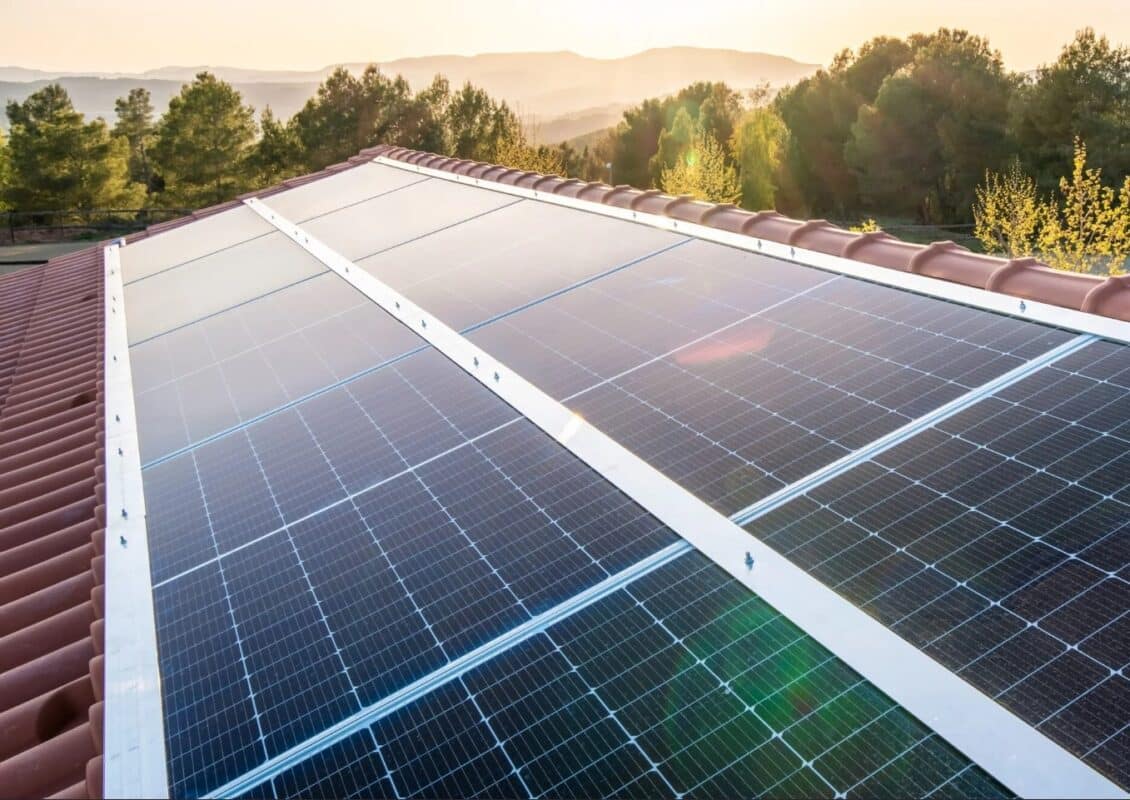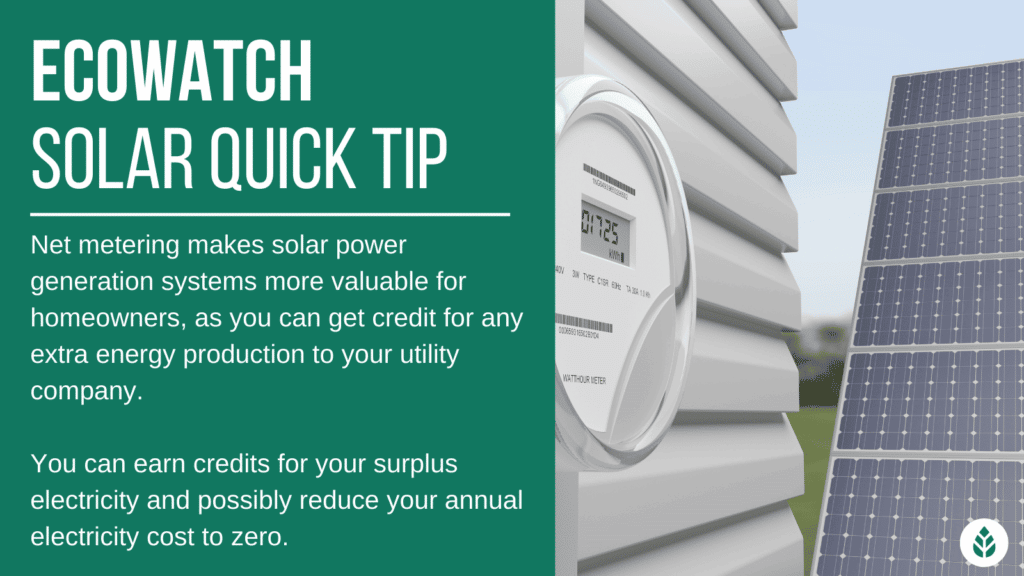 Reviews
Reviews

Solar Net Metering In 2024 (What To Know and How To Save)
In this EcoWatch guide on net metering, you’ll learn:
- What net metering is
- How net metering works
- How net metering credits can reduce your utility bills
- Whether net metering is available in your area
This guide has helped thousands of homeowners make the decision to go solar by illustrating how net metering programs can provide financial assistance. Let’s get started!
Each product and or company featured here has been independently selected by the writer. You can learn more about our review methodology here. If you make a purchase using the links included, we may earn commission.
What Is Net Metering?
Net energy metering (NEM) is a billing arrangement in which excess electricity production from photovoltaic (PV) solar panels is tracked by your electricity provider and subtracted from your monthly electric utility bill. When your solar system produces more kilowatt-hours of electricity than your home is consuming, the excess generation is fed back into the grid.
For solar customers, the benefits of net metering include higher monthly savings and a shorter payback period. Without this benefit, you only save on power bills when using solar energy directly, and surplus generation is lost unless you store it in a solar battery.
Utility companies also benefit, since the excess solar electricity can be supplied to other buildings on the same electric grid.
Generally, you will see more home solar renewable energy systems in places with favorable net metering laws. With this benefit, going solar becomes an attractive investment even for properties with minimal daytime consumption. Residential customers can turn their roofs into miniature power plants during the day, and that generation is subtracted from their nighttime consumption.
If a power grid relies on fossil fuels, net metering also increases the environmental benefits of solar power. Even if a building does not have an adequate area for rooftop solar panels, it can reduce its emissions by using the surplus clean energy from other properties.

SunPower

Nationwide Service
Average cost
Pros
- Most efficient panels on the market
- National coverage
- Cradle to Cradle sustainability certification
- Great warranty coverage
Cons
- Expensive
- Customer service varies by local dealer
SunPower designs and installs industry-leading residential solar and storage solutions across all 50 states. With a storied history of innovation dating back to 1985, no other company on this list can match SunPower’s experience and expertise.
SunPower earns its position as the top national installer on our list for a handful of reasons: It installs the most efficient solar technology on the residential market, offers the most expansive service area and backs its installations with a warranty well above the industry standard. All the while, SunPower pioneers sustainability efforts within the industry.
If that weren’t enough, SunPower systems come packaged with products all manufactured in-house by its sister company, Maxeon. This means that your panels, solar cells, inverters, battery and EV chargers are designed to work together and are all covered under the same warranty.
SunPower’s biggest downside? Its high-efficiency panels are considerably more expensive than most of its competitors’ products. However, its powerful panels are workhorses that make up for the initial cost with more backend production (think about this like spending more money for a car that gets more miles per gallon).
Facts and Figures: SunPower
| EcoWatch Rating |
|---|
| Better Business Bureau (BBB) Rating |
| Year Founded |
| Average Cost ($-$$$$$) |
| Solar Services |
| Brands of Solar Equipment Offered |
| Warranty Coverage |
| 5 |
| A+ |
| 1985 |
| $$$$ |
| Solar Panels, Solar Batteries, EV Chargers, System Monitoring |
| SunPower Panels |
| 25-year all-inclusive warranty |

Blue Raven Solar

Regional Service
Average cost
Pros
- Industry-leading in-house financing
- Competitive pricing
- Excellent reputation
Cons
- Doesn't offer solar batteries (coming 2022)
We like Blue Raven Solar because it understands that, for most homeowners, the cost of solar presents the biggest barrier to entry.
For that reason, Blue Raven Solar developed an innovative solar financing plan that offers in-house, flexible, zero-money-down options. The results speak for themselves, as Blue Raven Solar is now one of the fastest-growing solar companies in the nation and was recently acquired by SunPower. Its BluePower Plus+ plan (exclusive to Blue Raven) mimics the flexible structure of a lease while still providing the greatest benefits of owning your system.
Eligible homeowners enjoy 18 months of solar power before having to pay their first bill. When coupled with the federal solar investment tax credit (ITC), the initial energy savings can offset more than a third of the overall cost of a system before requiring a dollar down.
In contrast, other installers can only offer similar financing through solar leases, PPAs or third-party providers (such as Mosaic or Sunlight). Third-party loan providers can complicate the process, while opting for a loan or PPA will disqualify you from some of solar’s biggest benefits (additional property value, federal solar tax credit and local solar incentives).
Facts and Figures: Blue Raven Solar
| EcoWatch Rating |
|---|
| Better Business Bureau (BBB) Rating |
| Year Founded |
| Average Cost ($-$$$$$) |
| Solar Services |
| Brands of Solar Equipment Offered |
| Warranty Coverage |
| 4.5 |
| A+ |
| 2014 |
| $$ |
| Solar Panels, System Monitoring |
| Trina Solar, Canadian Solar, SolarEdge, Silfab, SunPower |
| 25-year manufacturer warranty; 10-year workmanship warranty, 2-year production guarantee |

How Does Net Metering Work?
There are two general ways net metering programs work:
- The excess energy produced by your solar panels is measured by your utility company, and a bill credit is posted to your account that can be applied to future power bills.
- The excess energy produced by your solar panels is measured by your home’s electricity meter. Modern power meters can measure electricity flow in both directions, so they tick up when you pull from the grid at night and count down when your solar panels are producing an excess amount of electricity.
In either scenario, at the end of the billing period, you will only pay for your net consumption — the difference between total consumption and generation. This is where the term “net metering” comes from.
How Net Metering Affects Your Electric Bill
Net metering makes solar power generation systems more valuable for homeowners, as you can get credit for any extra energy production to your utility company. However, it’s important to understand how charges and credits are managed:
- You can earn credits for your surplus energy use, but utility companies will not cut you a check for the power you provide. Instead, they will subtract the credits from your power bills.
- If your net metering credit during the billing cycle is higher than your consumption, the difference is rolled over to the next month.
- Some power companies will roll over your credit indefinitely, but many have a yearly expiration date that resets your credit balance.

All of this in mind, it is possible to reduce your annual electricity cost to zero through time-of-use. You can accumulate credit with surplus generation during the sunny summer months, and use it during winter when solar generation decreases. You will achieve the best results when your solar energy system has just the right capacity to cover your annual home consumption.
Oversizing your solar array is not recommended, as you will simply accumulate a large unused credit each year. In other words, you cannot overproduce and charge your power company each month. Some power companies will let you pick the expiration date of your annual net metering credits.
If you have this option, it’s wise to set the date after winter has ended. This way, you can use all the renewable energy credits you accumulated during summer.
If you’re ready to see how much you can save with solar energy, connect with one of these trusted EcoWatch providers noted below.
Is Net Metering Available Near You?
Net metering offers a valuable incentive for utility customers to switch to solar power, but these types of programs are not available everywhere. Net metering laws can change depending on where you live. In the U.S., there are regulatory net metering rules in 38 states and Washington, D.C.
Most states without a mandate have power companies or city governments that voluntarily offer the benefit in their service areas. For example, in Texas, net metering is available in San Antonio and Austin but not Houston or Dallas.
South Dakota and Tennessee are the only two states with no version of net metering or similar programs. If net metering is available in your area, you will be credited for your surplus energy in one of two ways:
- Net metering at full retail rate: You get full credit for each kilowatt-hour sent to the grid distribution system. For example, if you’re charged 16 cents per kWh consumed, you’ll get a bill credit of 16 cents per kWh exported. This type of net metering is required by law in just a few states, but many are abandoning this in favor of lower credit rates closer to the wholesale price of electricity.
- Net metering at a reduced feed-in tariff: Surplus electricity sent to the grid is credited at a lower rate. For example, you may be charged 16 cents per kWh for consumption but paid 10 cents per kWh exported. Feed-in tariffs and other alternative programs are used in most of the 33 states that offer net metering.
Note: This is just a simplified example — the exact kWh retail price and solar feed-in tariff will depend on your electricity plan.
The Database of State Incentives for Renewables & Efficiency (DSIRE) is an excellent resource if you want to learn more about net metering and other solar power incentives in your state.
You can also look for information about solar incentives by visiting the official websites of your state government and utility company.
Watch Below: See How States Like Florida Are Considering Reducing Their Net Metering Programs
Other Incentives to Go Solar
Net metering policies are one of the most effective incentives for solar power. However, there are other financial incentives and rebates that can be combined with net metering to improve your ROI:
-
- The federal solar tax credit lets you claim 30% of your solar installation costs as a tax deduction. For example, if your solar installation had a cost of $10,000, you can claim $3,000 on your next tax declaration. This benefit is available everywhere in the U.S.
If you’re ready to see how much you can save with solar energy, connect with one of these trusted EcoWatch providers noted below.
Related Articles:
FAQs: Net Metering
The EcoWatch team gets lots of questions about net metering. Below are some of the ones we see most often that you might be wondering about as well. If you have specific questions that aren’t answered here, reach out to our team of solar experts at solar@ecowatch.com.
When managed correctly, net metering is beneficial for electricity consumers and power companies. There have been cases in which power grid distribution systems lack the capacity to handle large amounts of power coming from homes and businesses. However, this is an infrastructure issue, not a negative aspect of net metering itself.
In places with a high percentage of homes and businesses using solar panels, surplus generation on sunny days can saturate the grid. This can be managed by modernizing the grid to handle distributed solar power more effectively with load management and energy storage systems.
With net metering, any electricity your solar panels produce that isn’t used to power your home is fed into your local power grid. Your utility company will pay you for this power production through credits that can be applied to your monthly energy bills.
You can reduce your power bills with net metering, using surplus solar generation to compensate for your consumption when you can’t generate solar power at night and on cloudy days. However, most power companies will not pay you for surplus production once your power bill has dropped to $0. Normally, that credit will be rolled over, to be used in months where your solar panels are less productive.
On very rare occasions, you may be paid for the accumulated balance over a year. However, this benefit is offered by very few electric companies and is subject to limitations.
Comparing authorized solar partners
-
- Most efficient panels on the market
- National coverage
- Cradle to Cradle sustainability certification
- Great warranty coverage
- Expensive
- Customer service varies by local dealer
A+Best National Provider1985SunPower Panels25-year all-inclusive warranty
Having trouble deciding? Click below and use our process to receive multiple quotes instead:

 233k
233k  41k
41k  Subscribe
Subscribe 






